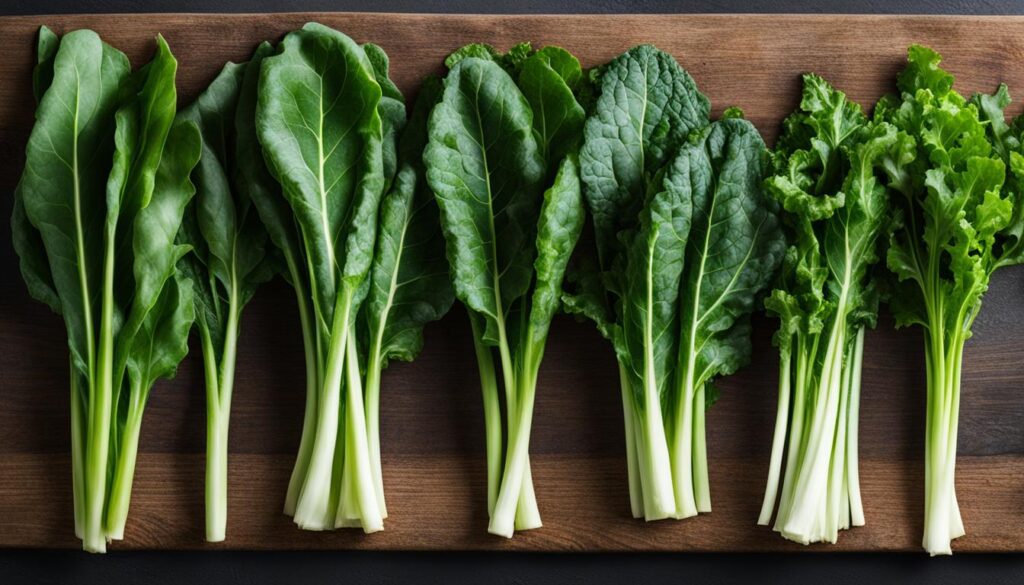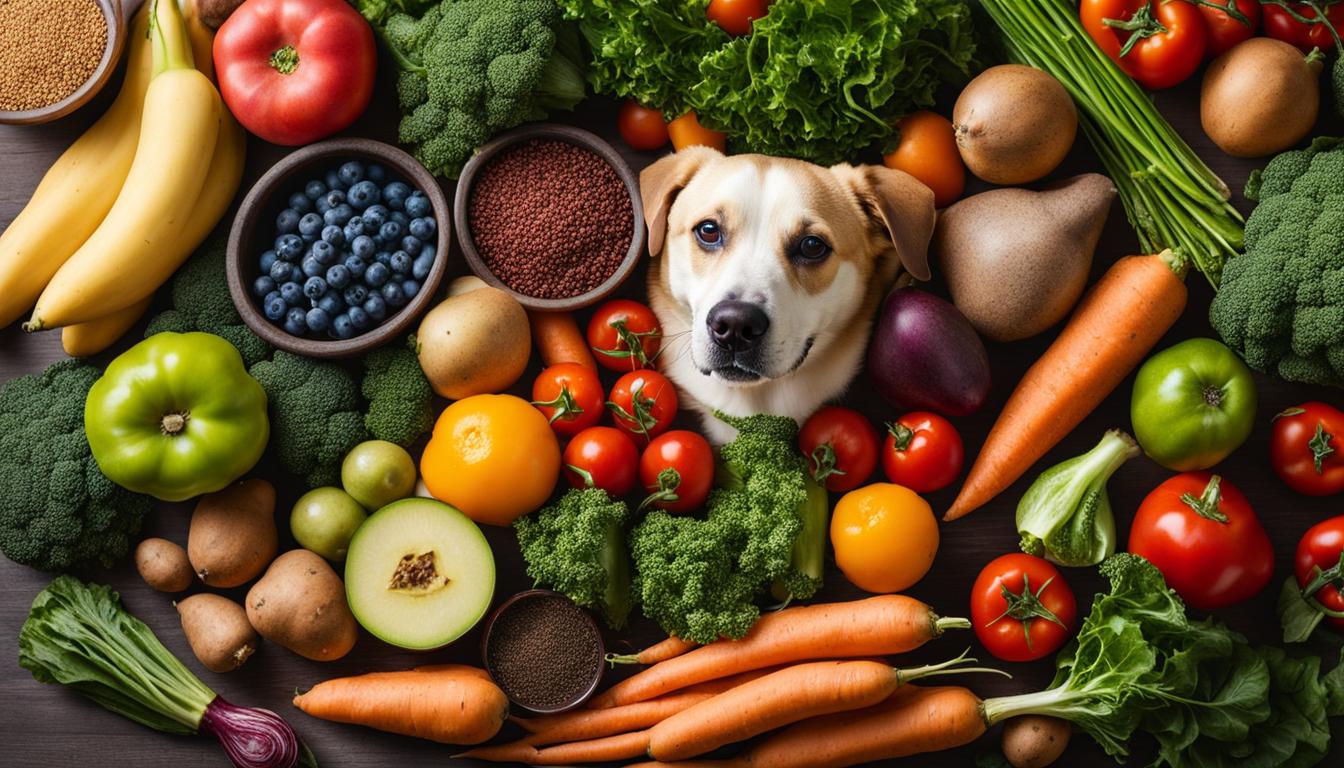Welcome to our guide on feeding dogs spinach! If you’ve ever wondered, “Can dogs eat spinach?” you’re not alone. Spinach is a controversial topic in the dog community, with opinions divided on whether it’s safe or beneficial for our furry friends. In this article, we’ll explore the nutritional benefits of spinach for dogs and address the safety concerns surrounding its consumption. Let’s dive in!
Key Takeaways:
- Spinach can provide nutritional benefits to dogs in small amounts.
- It is rich in vitamins A, B, C, and K, as well as iron, antioxidants, beta-carotene, and fiber.
- The debate centers around the high oxalic acid content in spinach, which can potentially lead to kidney damage.
- Dogs with healthy kidneys can generally tolerate small amounts of spinach, but it’s always best to consult with your veterinarian.
- If you decide to feed your dog spinach, steam it without any additional ingredients and chop it into small pieces for easier digestion.
The Pros of Feeding Dogs Spinach
Spinach offers numerous benefits for dogs, making it a healthy addition to their diet. This leafy green vegetable is rich in essential vitamins that support your dog’s overall health and wellbeing. It contains high levels of vitamins A, B, C, and K, which are essential for immune function, vision, and the growth and repair of cells. The antioxidants found in spinach help to protect your dog’s cells from damage caused by free radicals.
In addition to vitamins, spinach is also a great source of minerals like iron, which is vital for your dog’s oxygen transport and energy production. It also provides fiber, which aids in digestion and helps to keep your dog’s gastrointestinal tract healthy. The low-calorie nature of spinach makes it an ideal snack for dogs who may need to manage their weight.
By adding small amounts of spinach to your dog’s diet, you can provide them with these essential nutrients and contribute to their overall health and vitality. Remember to steam the spinach without any additional ingredients and chop it into small pieces to ensure easy digestion for your furry friend. Consult with your veterinarian to determine the appropriate portion size and frequency of spinach intake based on your dog’s specific needs.

Table: Nutritional Content of Spinach
| Nutrient | Amount per 100g |
|---|---|
| Vitamin A | 4690 IU |
| Vitamin B6 | 0.195 mg |
| Vitamin C | 28.1 mg |
| Vitamin K | 483.9 mcg |
| Iron | 2.71 mg |
| Fiber | 2.2 g |
The Cons of Feeding Dogs Spinach
When it comes to feeding dogs spinach, there are a few risks and potential drawbacks to consider. The main concern is the high content of oxalic acid found in spinach. Oxalic acid can interfere with calcium absorption and may lead to kidney damage if consumed in large amounts. While dogs with healthy kidneys can handle small amounts of soluble oxalates found in spinach, long-term consumption of large quantities could potentially cause kidney stress, muscle weakness, abnormal heart rhythms, and respiratory paralysis.
If your dog is prone to kidney or bladder stones, it is especially important to avoid feeding them foods like spinach. These conditions make dogs more susceptible to the negative effects of oxalic acid. While it is true that spinach offers nutritional benefits, it’s crucial to weigh them against the potential risks.
Consult with your veterinarian before adding spinach to your dog’s diet, especially if your dog has pre-existing health conditions or a history of kidney problems. Your vet can provide personalized guidance based on your dog’s specific needs and health status. They can help determine whether or not spinach is a suitable addition to your dog’s diet and recommend alternatives if necessary.
The Role of Oxalic Acid in Spinach and Dog Health
Oxalic acid is a naturally occurring compound found in many plants, including spinach. While humans can handle moderate amounts of oxalic acid, dogs have a different susceptibility due to their different digestive systems. The potential for kidney damage in dogs is a key concern related to the oxalic acid content in spinach. Therefore, it’s essential to monitor the amount of spinach your dog consumes and consult with your vet to determine a safe serving size.
| Potential Risks | Safe Guidelines |
|---|---|
| Kidney damage | Consult with your vet before feeding spinach to your dog, especially if they have a history of kidney problems. |
| Muscle weakness and abnormal heart rhythms | Monitor your dog’s spinach intake and keep portion sizes small and infrequent. |
| Respiratory paralysis | Avoid feeding spinach to dogs prone to kidney or bladder stones. |
“Feeding spinach to dogs can provide some nutritional benefits, but it is important to consider the potential risks associated with its high oxalic acid content.” – Veterinarian Dr. Smith
While the decision to feed your dog spinach ultimately rests with you and your veterinarian, it’s crucial to be aware of the potential risks and take appropriate precautions. By following safe guidelines and monitoring your dog’s spinach intake, you can make an informed decision to ensure your furry friend’s health and well-being.
How to Safely Feed Spinach to Dogs
If you decide to incorporate spinach into your dog’s diet, it’s important to follow these guidelines to ensure their safety and well-being. Here are some steps you can take to safely prepare and serve spinach to your furry friend:
1. Steaming is the Best Cooking Method
When cooking spinach for your dog, steaming is the preferred method. Steaming helps retain most of the nutrients in the spinach and makes it easier for your dog to digest. Avoid boiling the spinach, as it can result in the loss of essential vitamins and minerals.
2. Keep It Plain and Simple
When preparing spinach for your dog, it’s important to keep it plain and free from any additives or seasonings. Avoid adding salt, oil, herbs, or spices, as these can be harmful to dogs. Additionally, be mindful of not including any onions or garlic, as these foods are toxic to dogs.
3. Chop Into Small Pieces
A dog’s digestive system is different from ours, so it’s best to chop the spinach into small, bite-sized pieces. This will make it easier for your dog to chew and digest the spinach without any discomfort.
4. Consult with Your Veterinarian
Before adding spinach to your dog’s diet, it’s always a good idea to consult with your veterinarian. They can provide personalized guidance based on your dog’s specific needs and health status. Your vet will be able to advise you on the appropriate portion sizes and frequency of spinach intake for your furry friend.
By following these steps, you can safely introduce spinach into your dog’s diet and provide them with the potential nutritional benefits it offers. Remember, moderation is key, and always make sure to monitor your dog for any adverse reactions. If you notice any unusual symptoms or concerns, consult with your veterinarian.

| Cooking Method | Nutrient Retention | Digestibility |
|---|---|---|
| Steaming | High | Easy |
| Boiling | Low | Medium |
| Raw | High | Difficult |
Considerations and Alternatives
Before introducing spinach to your dog’s diet, it is important to consider any potential allergies or sensitivities your dog may have. Not all dogs tolerate spinach well, and some may experience digestive issues or allergic reactions. If you notice any signs of an adverse reaction, such as vomiting, diarrhea, or excessive itching, it is best to discontinue feeding spinach and consult with your veterinarian.
If you’re hesitant about feeding spinach to your dog, there are alternative leafy green vegetables that can provide similar nutritional benefits. These alternatives include kale, arugula, lettuce, cabbage, collard greens, and Swiss chard. These leafy greens also contain vitamins, minerals, and fiber that can support your dog’s overall health. However, as with any new food, it is essential to introduce these alternatives gradually and in small portions to ensure your dog tolerates them well.
When considering alternatives to spinach, it is important to remember that not all vegetables are safe for dogs. Some vegetables, such as onions, garlic, and mushrooms, can be toxic to dogs and should be avoided. Always do your research and consult with your veterinarian to ensure you are making the best choices for your dog’s diet.
Table: Leafy Greens Comparison
| Leafy Greens | Nutritional Benefits | Feeding Guidelines |
|---|---|---|
| Kale | High in vitamins A, C, and K, as well as calcium and fiber | Offer in small amounts, steamed or chopped, as part of a balanced diet |
| Arugula | Contains vitamins A, C, and K, and is a good source of calcium | Introduce gradually, offer in moderation as a treat or mixed in with regular food |
| Lettuce | Low in calories and a source of vitamins A and K | Use as a small portion of a balanced meal, avoid dressings or toppings |
| Cabbage | Rich in vitamins C and K, as well as fiber | Offer in small amounts, cooked or steamed, as an occasional addition to meals |
| Collard Greens | High in vitamins A, C, and K, and a good source of calcium and fiber | Introduce gradually, feed in small portions to avoid digestive upset |
| Swiss Chard | Packed with vitamins A, C, and K, as well as iron and fiber | Steam or sauté before serving, offer in moderation as part of a balanced diet |
Remember, every dog is unique, and their dietary needs may vary. It is always best to consult with your veterinarian before making any significant changes to your dog’s diet. They can provide personalized recommendations based on your dog’s specific needs, health status, and any potential allergies or sensitivities.

Feeding Guidelines for Spinach
When it comes to feeding spinach to your dog, it’s essential to keep portion sizes in mind. While spinach can provide some nutritional benefits, it should only make up a small part of your dog’s overall diet. Treats, including spinach, should make up no more than 10% of your dog’s daily food intake, with the remaining 90% consisting of a well-balanced dog food.
The recommended portion sizes of steamed, chopped spinach vary depending on the size of your dog. For extra-small dogs weighing 2-20 pounds, a portion can be as little as 1/4 teaspoon. Small to medium-sized dogs weighing 21-50 pounds can have up to 1 teaspoon of spinach. Larger dogs weighing 51-90 pounds can consume up to 2 teaspoons, and extra-large dogs weighing 91+ pounds can have up to 1 tablespoon of spinach. It’s important to adhere to these portion sizes to prevent any potential digestive issues or nutrient imbalances.
Remember, moderation is key when it comes to feeding your dog spinach. While it can be a valuable addition to their diet, it should not be the main source of nutrition. Always consult with your veterinarian before introducing any new food to your dog’s diet, including spinach, to ensure it is suitable for their individual needs and health status. Your veterinarian can provide personalized guidance based on their specific requirements.
| Dog Size | Spinach Portion Size |
|---|---|
| Extra-Small (2-20 lbs) | 1/4 teaspoon |
| Small to Medium (21-50 lbs) | 1 teaspoon |
| Large (51-90 lbs) | 2 teaspoons |
| Extra-Large (91+ lbs) | 1 tablespoon |
By following these feeding guidelines, you can safely incorporate spinach into your dog’s diet, providing them with some additional nutrients while still maintaining a balanced and healthy approach to their overall nutrition.
Conclusion
In summary, feeding your dogs spinach can provide some nutritional benefits, but it’s important to be mindful of the potential risks associated with its high oxalic acid content. While small amounts of spinach are generally safe for dogs with healthy kidneys, it’s always a good idea to consult with your veterinarian before introducing any new foods into your dog’s diet.
If you do choose to feed your dog spinach, make sure to steam it without adding any additional ingredients and chop it into small pieces for easier digestion. Remember to keep portion sizes small and infrequent, as treats, including spinach, should only make up a maximum of 10% of your dog’s overall diet.
If you have any concerns about feeding your dog spinach, there are alternative leafy green vegetables that can provide similar nutritional benefits. Consider options such as kale, arugula, lettuce, cabbage, collard greens, or Swiss chard. Your veterinarian can offer personalized guidance based on your dog’s specific needs and health status.
Ultimately, the decision to feed your dog spinach should be made in consultation with your veterinarian. They can help you determine the best course of action based on your dog’s individual circumstances. By taking these precautions and being mindful of portion sizes, you can ensure that your dog enjoys the potential benefits of spinach while minimizing any potential risks.
FAQ
Can dogs eat spinach?
Yes, dogs can eat spinach in small amounts.
What are the nutritional benefits of spinach for dogs?
Spinach is rich in vitamins A, B, C, and K, iron, antioxidants, beta-carotene, and fiber, which can support immune function, vision, and overall health, as well as contribute to a healthy digestive system.
Is spinach safe for dogs to eat?
Small amounts of spinach are generally safe for dogs with healthy kidneys. However, spinach contains oxalic acid, which can interfere with calcium absorption and potentially lead to kidney damage in large quantities.
What are the risks of feeding dogs spinach?
The high oxalic acid content in spinach can potentially cause kidney stress, muscle weakness, abnormal heart rhythms, and respiratory paralysis if consumed in large amounts. It is especially important for dogs prone to kidney and bladder stones to avoid spinach.
How should I safely feed spinach to dogs?
The best way to prepare spinach for dogs is by steaming it. Avoid boiling, as it can result in nutrient loss, and raw spinach can be difficult for dogs to digest. Chop the spinach into small pieces and do not add any spices, herbs, salt, oil, onion, or garlic, as these can be toxic to dogs.
Are there any considerations or alternatives to feeding dogs spinach?
Before feeding your dog spinach, consider any potential allergies or sensitivities. It is also recommended to consult with your veterinarian, especially for dogs with pre-existing health conditions or a history of kidney problems. If you’re hesitant about spinach, there are alternative leafy green vegetables such as kale, arugula, lettuce, cabbage, collard greens, or Swiss chard.
What are the recommended serving sizes of spinach for dogs?
The portion sizes of steamed, chopped spinach depend on the size of your dog. For extra-small dogs (2-20 pounds), 1/4 teaspoon is recommended, while extra-large dogs (91+ pounds) can have up to 1 tablespoon. Adhere to these portion sizes to prevent digestive issues or nutrient imbalances.
What is the summary of feeding dogs spinach?
Feeding dogs spinach can provide nutritional benefits, but it is essential to consider the potential risks due to its oxalic acid content. Small amounts are generally safe for dogs with healthy kidneys, but consulting with a veterinarian is recommended. Steam spinach without any additional ingredients, chop it into small pieces, and keep portion sizes small and infrequent. Consider alternative leafy greens if you have concerns about spinach.





